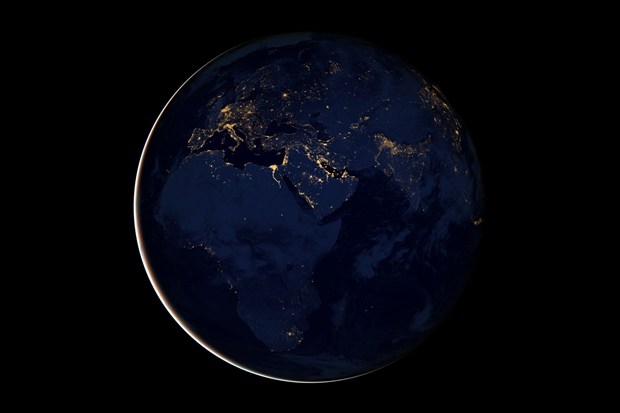Report
by Scott Kardel
In early December NASA released a new global map of our Earth at night. The new ‘Black Marble’ images show that our world isn’t so black. In fact, it is littered with light.

The pictures come from the Suomi National Polar-orbiting Partnership (SNPP) satellite. They give a much higher resolution view than the older Earth at Night images produced by the Defense Meteorological Satellite Program.
If you haven’t yet done so, you’ll want to have a look at your community through this great navigator of the imagery. You’ll be able to easily cruise around the globe and see that our nights aren’t so dark.
According to the International Dark-Sky Association the new images "reveal that our globe is heavily littered with excessive and wasteful lighting that produces light pollution – a bright glow over our cities that not only masks the stars but wastes vast amounts of energy."
IDA is correct. There is a lot of wasteful light going upwards, serving no useful purpose at all. This light brightens our night sky and masks our view of the universe. Unfortunately while the satellite can measure the light shining up into space it cannot measure the brightness of the night sky above our cities. If we want to understand the real impact of our lights and the light pollution they produce it is important to measure this sky glow from down on the ground were we happen to be.
Thankfully there is an easy way to see how bright our skies really are. All you need to do is get out there and take a look at the night sky. It should be no problem at all for you to notice the glow from your city or town. I encourage you to out and take a look. You’ll especially want to do so on a clear moonless night.
Let me suggest that you try to do so on these nights:
January 31 - February 9, 2013
March 3 - 12, 2013
March 31 - April 9, 2013
April 29 - May 8, 2013
Those are great nights to go out and look at your local sky glow because those are the nights that the GLOBE at Night campaign takes place for 2013. As you look at your own sky you can join with people from all over the planet in making measurements that show the impacts of our lighting.

The process of making the measurements is easy. No special equipment is needed – just follow the steps on the GLOBE at Night website.
In 2012 over 16,000 observations were made from 92 different countries. We would like to greatly increase those numbers for 2013 and with your help it can be done.
Documenting sky glow helps us to understand changes in our nighttime environment and the relationship between what we experience on the ground and what is measured by satellite.
###
 Scott Kardel has always had a love for astronomy and the universe. Growing up in the desert on the edge of Tucson, Arizona gave him a strong connection to the sky and the environment. He works for the International Dark-Sky Association helping to defend the night and was previously at Palomar Observatory. There he directed their public outreach programs and was the observatory’s representative on light pollution issues.
Scott Kardel has always had a love for astronomy and the universe. Growing up in the desert on the edge of Tucson, Arizona gave him a strong connection to the sky and the environment. He works for the International Dark-Sky Association helping to defend the night and was previously at Palomar Observatory. There he directed their public outreach programs and was the observatory’s representative on light pollution issues.








Comments